Related Research Articles
In the mathematical field of algebraic topology, the fundamental group of a topological space is the group of the equivalence classes under homotopy of the loops contained in the space. It records information about the basic shape, or holes, of the topological space. The fundamental group is the first and simplest homotopy group. The fundamental group is a homotopy invariant—topological spaces that are homotopy equivalent have isomorphic fundamental groups. The fundamental group of a topological space is denoted by .

Algebraic topology is a branch of mathematics that uses tools from abstract algebra to study topological spaces. The basic goal is to find algebraic invariants that classify topological spaces up to homeomorphism, though usually most classify up to homotopy equivalence.

In topology, a branch of mathematics, two continuous functions from one topological space to another are called homotopic if one can be "continuously deformed" into the other, such a deformation being called a homotopy between the two functions. A notable use of homotopy is the definition of homotopy groups and cohomotopy groups, important invariants in algebraic topology.
In mathematical physics, a closed timelike curve (CTC) is a world line in a Lorentzian manifold, of a material particle in spacetime, that is "closed", returning to its starting point. This possibility was first discovered by Willem Jacob van Stockum in 1937 and later confirmed by Kurt Gödel in 1949, who discovered a solution to the equations of general relativity (GR) allowing CTCs known as the Gödel metric; and since then other GR solutions containing CTCs have been found, such as the Tipler cylinder and traversable wormholes. If CTCs exist, their existence would seem to imply at least the theoretical possibility of time travel backwards in time, raising the spectre of the grandfather paradox, although the Novikov self-consistency principle seems to show that such paradoxes could be avoided. Some physicists speculate that the CTCs which appear in certain GR solutions might be ruled out by a future theory of quantum gravity which would replace GR, an idea which Stephen Hawking labeled the chronology protection conjecture. Others note that if every closed timelike curve in a given space-time passes through an event horizon, a property which can be called chronological censorship, then that space-time with event horizons excised would still be causally well behaved and an observer might not be able to detect the causal violation.
In differential geometry, a pseudo-Riemannian manifold, also called a semi-Riemannian manifold, is a differentiable manifold with a metric tensor that is everywhere nondegenerate. This is a generalization of a Riemannian manifold in which the requirement of positive-definiteness is relaxed.
In mathematics, homotopy groups are used in algebraic topology to classify topological spaces. The first and simplest homotopy group is the fundamental group, denoted which records information about loops in a space. Intuitively, homotopy groups record information about the basic shape, or holes, of a topological space.
Topological defects or solitons are irregularities or disruptions that occur within continuous fields or ordered states of matter. These defects, which can take various forms such as points, lines, or surfaces, are characterized by their stability and the fact that they cannot be 'smoothed out' or removed through continuous transformations of the field or material. They play a significant role in various areas of physics, including condensed matter physics, cosmology, and quantum field theory, and can have profound effects on the properties and behavior of the systems in which they occur.

In the mathematical field of algebraic topology, the homotopy groups of spheres describe how spheres of various dimensions can wrap around each other. They are examples of topological invariants, which reflect, in algebraic terms, the structure of spheres viewed as topological spaces, forgetting about their precise geometry. Unlike homology groups, which are also topological invariants, the homotopy groups are surprisingly complex and difficult to compute.

In mathematics, a path in a topological space is a continuous function from the closed unit interval into

In mathematics, a topological space X is contractible if the identity map on X is null-homotopic, i.e. if it is homotopic to some constant map. Intuitively, a contractible space is one that can be continuously shrunk to a point within that space.
In the mathematical field of Lorentzian geometry, a Cauchy surface is a certain kind of submanifold of a Lorentzian manifold. In the application of Lorentzian geometry to the physics of general relativity, a Cauchy surface is usually interpreted as defining an "instant of time"; in the mathematics of general relativity, Cauchy surfaces are important in the formulation of the Einstein equations as an evolutionary problem.

In mathematics, an immersion is a differentiable function between differentiable manifolds whose differential pushforward is everywhere injective. Explicitly, f : M → N is an immersion if
In mathematics, specifically geometric topology, the Borel conjecture asserts that an aspherical closed manifold is determined by its fundamental group, up to homeomorphism. It is a rigidity conjecture, asserting that a weak, algebraic notion of equivalence should imply a stronger, topological notion.
Suppose a Lorentzian manifold contains a closed timelike curve (CTC). No CTC can be continuously deformed as a CTC to a point, as that point would not be causally well behaved. Therefore, any Lorentzian manifold containing a CTC is said to be timelike multiply connected. A Lorentzian manifold that does not contain a CTC is said to be timelike simply connected.
In mathematical physics, the causal structure of a Lorentzian manifold describes the causal relationships between points in the manifold.

Spacetime topology is the topological structure of spacetime, a topic studied primarily in general relativity. This physical theory models gravitation as the curvature of a four dimensional Lorentzian manifold and the concepts of topology thus become important in analysing local as well as global aspects of spacetime. The study of spacetime topology is especially important in physical cosmology.
In mathematics, especially in algebraic topology, an induced homomorphism is a homomorphism derived in a canonical way from another map. For example, a continuous map from a topological space X to a topological space Y induces a group homomorphism from the fundamental group of X to the fundamental group of Y.
In mathematics, particularly the branch called category theory, a 2-group is a groupoid with a way to multiply objects, making it resemble a group. They are part of a larger hierarchy of n-groups. They were introduced by Hoàng Xuân Sính in the late 1960s under the name gr-categories, and they are also known as categorical groups.
In the mathematical field of topology, a manifold M is called topologically rigid if every manifold homotopically equivalent to M is also homeomorphic to M.
In algebraic topology, the fundamental groupoid is a certain topological invariant of a topological space. It can be viewed as an extension of the more widely-known fundamental group; as such, it captures information about the homotopy type of a topological space. In terms of category theory, the fundamental groupoid is a certain functor from the category of topological spaces to the category of groupoids.
[...] people still obstinately persist, when calculating with fundamental groups, in fixing a single base point, instead of cleverly choosing a whole packet of points which is invariant under the symmetries of the situation, which thus get lost on the way. In certain situations it is much more elegant, even indispensable for understanding something, to work with fundamental groupoids with respect to a suitable packet of base points, [,,,]
References
- J. Wolfgang Smith (1960). "Fundamental groups on a Lorentz manifold". Amer. J. Math. The Johns Hopkins University Press. 82 (4): 873–890. doi:10.2307/2372946. hdl: 2027/mdp.39015095257625 . JSTOR 2372946. PMC 285022 . PMID 16590583.
- André Avez (1963). "Essais de géométrie riemannienne hyperbolique globale. Applications à la relativité générale". Annales de l'Institut Fourier . 13 (2): 105–190. doi: 10.5802/aif.144 .